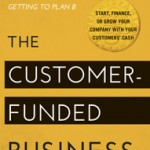
Start-ups need money. Desperately. But too much money raised in Seed and Series A rounds could be devastating, says London Business School Professor John Mullins.
How could that be?
Mullins, an angel investor himself, suggests that money can make start-ups sloppy, cause stupid decisions, and to make things worse, funders would want start-ups to implement Plan A no matter how immature that plan is, resulting in a complete failure.
But if that is the case, what should entrepreneurs and investors do?
Solutions are outlined in his 2014 new book “The Customer-Funded Business: Start, Finance, or Grow Your Company with Your Customers’ Cash.” In this 304-page book, Mullins introduces five models that early-stage entrepreneurs may follow to jump-start their business.
Those five models are Matchmaker models, Pay-in-advance models, Subscription models, Scarcity models, and Service-to-product models.
Matchmaker models. Airbnb and Expedia execute this model, in which the company brings together buyers and sellers but it never touches the product. Those companies then get their revenue from sellers (e.g. listers in the case of Airbnb) and buyers (renters in the case of Airbnb).
Pay-in-advance models. Traces of this model can be seen almost everywhere in our daily life. Dell, for example, demonstrates how this model works in pre-tech-boom time. You simply ask the customer to pay for the product before they will use it. An example worth studying is via.com, formerly known as flightraja.com. Established in 2006, the company set up partnerships with travel agencies. For the service fee those partner agencies pre-paid, Via promoted their travel products or services on the website, assisting those agencies to reach the most suitable and desired customers.
Subscription models. This model is generally adopted by companies such as Netflix, and is very self-explanatory.
Scarcity models. Zara demonstrates the essence of this model. Companies offer products that are only available for a limited amount of time or in limited quantity, attracting customers’ instant desire to consume. A more recent attempt is detected in VentePrivee.com, a France-headquartered e-commerce company that works with suppliers to sell their excess inventories in a limited time. Sales usually last 3-5 days and are only available to registered members.
Service-to-product models. GoViral, a company that is now owned by AOL, started making viral videos to aid marketing campaigns for their clients in 2003. As content reaching millions of viewers, the company grew into a viral marketing platform and began developing products such as “Be 360°” and “Be Engaged.”
As Mullins noted in a NYC Meetup event hosted by New York Angels, companies utilizing those models share one thing in common: They require less external capital to get started, and when they do (and given their concept is proven), angles or VCs are already lining up to invest in them.
Despite the effectiveness these models may have presented, it is essential for start-ups to think carefully which ones are the best for their sake. It is also important to notice, while those models are insightful in that they offer smart alternatives to VCs, they don’t necessarily help you get business started. After all, subscriptions didn’t give birth to Netflix; it only adds glory and sustains consistent revenues.
To learn more about John Mullins or his book, you may go to: johnwmullins.com.




Pingback: Airbnb和Netflix为什么能赚钱:五个商业模式教你把客户变成投资者 | IntroAmerica 中文版()